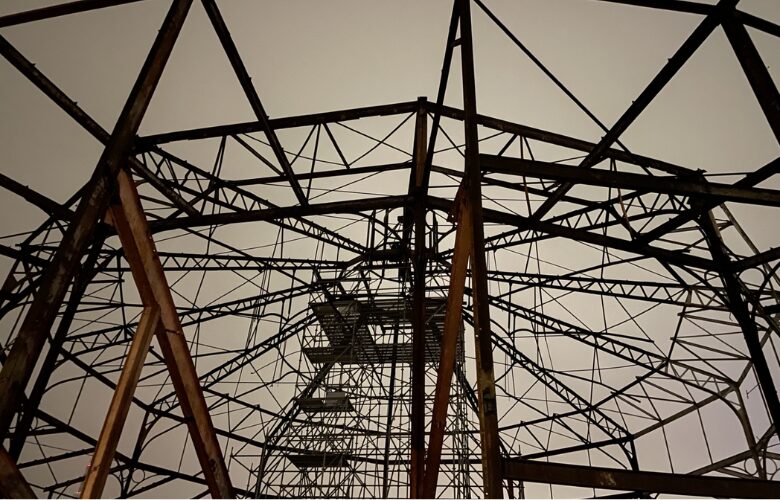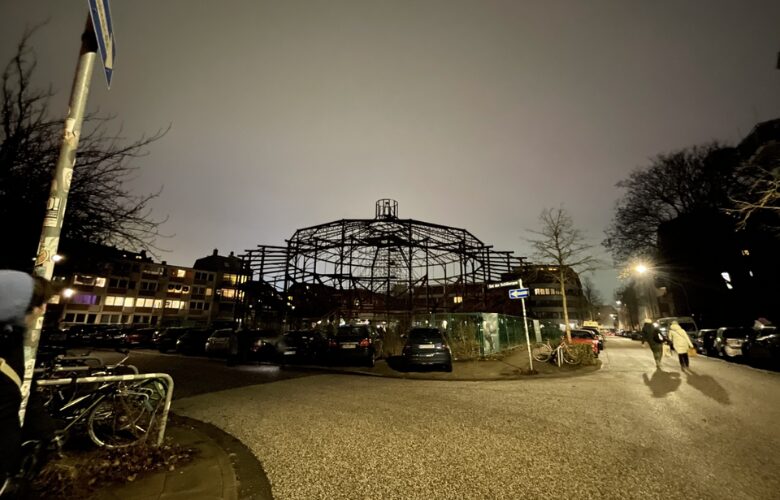Between Past and Future of Schiller Opera

This article is part of the “Inter-magazine Circus Festival” project that is a collaboration between the Université Libre de Bruxelles and three international circus magazines, Around About Circus, Juggling Magazine and StageLync all part of the INCAM network. In the second issue, students from the Université Libre de Bruxelles share their thoughts on circus architecture. The analysis of historical and contemporary circus buildings is thereby used as a starting point for discussions on broader issues concerning artistic, social, cultural, and historical interrelations. The exchanges that took place during the international conference New Circus. New Architectures at Latitude 50 in November 2024 offered a source of inspiration. The student’s diverse backgrounds—ranging from literature, journalism, comics studies, visual arts or cultural studies —bring unique perspectives, whether familiar with the art form or newcomers. They are united by a curiosity for performing arts, which led them to the MA Arts du spectacle program, offering exposure to various art forms, including the circus. As part of the Circus | Studies, an interdisciplinary and international research project led by Dr. Franziska Trapp, theatre students explore circus dramaturgy, collaborate with emerging artists, and engage in performance analysis and critique. Their experiences culminate in MA theses or articles like the following.
Imagine turning a corner in a city that you lived in for 6 years and discovering something completely new to you. Something big and impressive, making clear to you that you only know half of what’s going on in this city. I experienced this on a random evening during the corona pandemic. I took upon the habit of taking long walks through the empty streets, discovering the city without being guided by people.
This evening, I suddenly stood before a massive, circular steel structure. Half-covered in plastic, empty surfaces scattered with graffiti, like inked remnants of forgotten stories. There was no plaque, no name — just a skeletal frame as a landscape of memory.
That was the first time I encountered the Schiller Opera. I felt compelled to understand it, to uncover its story — the memories it holds, the history it carries, and the potential that still lingers within its abandoned frame. To truly grasp its significance, we must look back into its past. (1) (2)
The Schiller Opera was built between 1889-1891 in the center of Hamburg for the Circus Busch. The structure included not only the main rotunda — a steel skeleton framework — but also apartments for performers, a props storage room, and stables for elephants. In 1891 it opened its doors to 3.000 visitors for a circus gala performance. However, Circus Busch moved out of the building as early as 1899.
In 1905, the building was repurposed as a theatre, reopening with the play Wilhelm Tell by Schiller and was thus named ‘Schiller Opera’. The theater struggled to maintain its existence, adapting in part to the propaganda -driven cultural policies of Nazi cultural Minister Joseph Goebbels. Its programming was contradictory: on the one hand it featured plays written by Goebbels himself and on the other hand it hosted concerts by Paul Hindemith whose work was prohibited by the Nazis or Franz Lehar who worked exclusively with Jewish authors (but enjoyed special interest from Hitler and Goebbels).

At the beginning of World War II , the theatre was closed, and the building was converted into a prison camp. Despite severe damage from an incendiary bomb, after the war, the building served as accommodation for people who had lost their homes. Over the following decades, it continued to serve various functions, as a hotel, workers’ quarters, refugee camp, or warehouse.
There were numerous attempts to restore its cultural purpose, with proposals envisioning it as a winter circus for the Circus Barum or as an alternative venue for the Deutsches Schauspielhaus. However, the political and logistical challenges of redeveloping the site — alongside its complicated history — have kept it in a state of limbo, a monument to both its past and unrealized potential.
Can the history of this location, which contributed to the Nazi regime, be reflected through a change of use? Any plans were prevented by city politics, or the owners and any agreement is impossible to this day. In addition, the ruins have been listed as a heritage site since 2013, otherwise, it would most likely have been converted to a car park long ago. Involuntarily, the Schiller Opera House has become a symbol of failure, as the city and the owners are dragging out the discussion over such a long period that it suggests that deterioration is more desirable than repurposing.
How can we deal with this stagnation? Perhaps now is the time to re-think this ‘place without use’. Rather than seeing it as an abandoned space, we should consider how it contributes to Hamburg’s cityscape and to the reality and imagination of those who pass by — whether intentionally or by chance
While researching this article, I recalled a friend who has the Schilleroper tattooed on the back of her upper arm. I asked her what she associates with this place. In our conversation, I learned that she even created an exhibition in 2019 called Frankfurt Schillert as part of her studies in theatre direction. She allowed me to share an excerpt from her text.
To me, this theatre ruin […] stands for much more today. It reminds me of people […] carefully holding hands and intimate kisses. Of sunsets with beer and cigarettes and, above all, of ideas! No, of visions. Plans for the future – directorial concepts – wild fantasies […] It was a meeting point in the quiet and a gathering place at a large-scale. When I go to Hamburg today and visit the Schiller Opera, it is melancholy and a warm rush of old things tipping over into the new – of ruins that remain standing.– Jette Büshel (3)
She also explained to me that the Schiller Opera allowed her and her friends to engage with history and to understand that the emptiness of the building had reclaimed it from the Nazis. The area around the Schiller Opera House is a quiet place, inviting you to look and linger. It is a calm island in an otherwise busy neighbourhood. It is a dystopian place, where its materiality reflects failed projects, crushed dreams, and decay.
Doesn’t scaffolding always signify that something new is being constructed?
Perhaps the current state of this non-place is an indication of a utopia – one that exists in the imagination, not (yet) in reality. However, the Schiller Opera House is very real, anchored in people’s lives and perceptions through both its past and its presence in public space. There is extensive archival material and a long history of failed proposals by people who had visions for this place.
This brings to mind the concept of “heterotopia” as defined by the French philosopher Michel Foucault. (4) He uses this term to describe spaces that have more layers of meaning or relationships to its surroundings than it seems at first glance. A bed can become a forest, an attic a refuge and an old ruin a theatre.
Much like my initial feeling upon encountering the Schiller Opera, my friend Jette’s description affirms that this is more than just a building. The Schiller Opera is deeply connected to Hamburg and its history, woven into the everyday lives of many through its presence. It’s both a part of and an active participant in the social structure that surrounds it.
The Schiller Opera and its grounds exist in a liminal space on the border between life and death – between usage and existence. The concept of heterotopia encourages us to rethink the ‘utilisation and usefulness of public space’ in an anti-capitalist way. This place serves as a memorial to the past, but perhaps also as a symbol and reminder for the future.
Culture carries responsibility, it is a space for negotiation and a mirror of prevailing social conditions. This is especially true now, as Germany’s political climate becomes more conservative and right-wing, with cultural funding for performative arts being cut in almost all federal states. In such times , places of remembrance, mourning and dreaming are essential.
Of course, I understand why many would want to see this space revitalized, but I would rather preserve its current impact. I envision people hurrying beneath it , children playing nearby, young people and students gathering, the scaffold serving as (reminding) crutch for the elderly and offering shelter for homeless people from the elements. Its very existence sparks reflection, planting thoughts and ideas in the mind of those who pass by.
References: (1) Soul Pauli: Schiller-Oper. URL: https://soul-pauli.de/schiller-oper/ (20.01.2025) (2) Wikipedia: Schilleroper. URL: https://de.wikipedia.org/wiki/Schilleroper (20.01.2025) (3) Frankfurt Schillert, Jette Büshel (Premiere Februar 2019). (4)Foucault, M. (2005). Die Heterotopien. Der utopische Körper: Zwei Radiovorträge (M. Bischoff, Übers.; 1. Aufl.). Suhrkamp.Main Image: Schilleroper, Dezember 2024 Photo: C. Pfingsten
To access all the articles in the 2nd “Inter-magazine Circus Festival” project please visit the International Network of Circus Arts Media Projects website.
Editor's Note: At StageLync, an international platform for the performing arts, we celebrate the diversity of our writers' backgrounds. We recognize and support their choice to use either American or British English in their articles, respecting their individual preferences and origins. This policy allows us to embrace a wide range of linguistic expressions, enriching our content and reflecting the global nature of our community.
🎧 Join us on the StageLync Podcast for inspiring stories from the world of performing arts! Tune in to hear from the creative minds who bring magic to life, both onstage and behind the scenes. 🎙️ 👉 Listen now!
